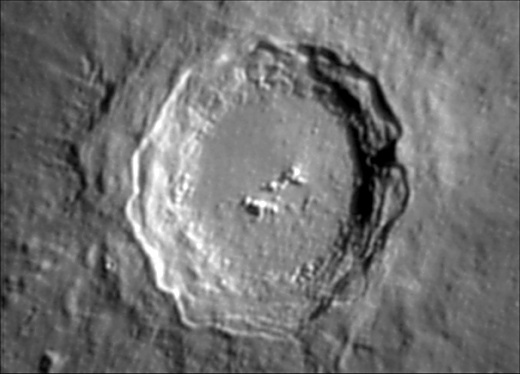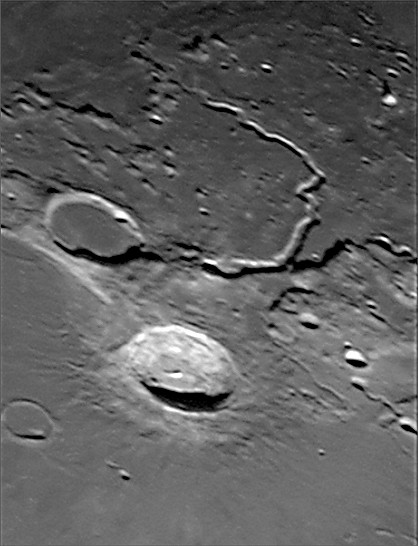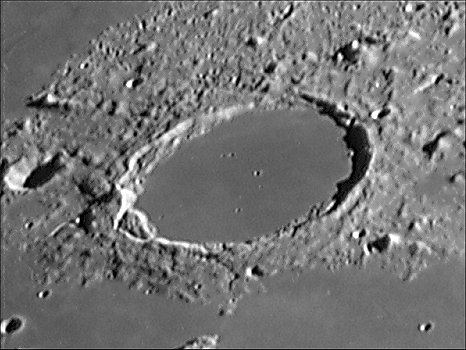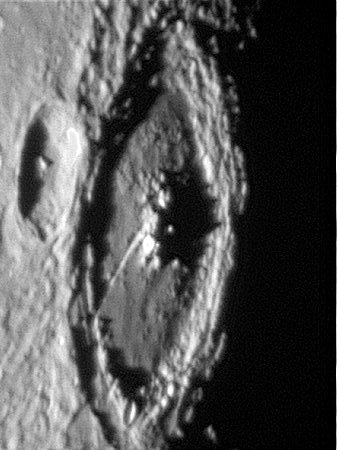![]()
Below is a picture of Copernicus
crater taken on 03/20/2005 at the focus of a 8" MEADE LX200
telescope equipped with a lengthened 3x Barlow lens (F/D=30). The
camera used is a Philips Vesta Pro model. This picture results
from a combination of 15 raw pictures processed with IRIS software.
Copernicus arena is 93km wide.
Strangely, Copernic is hexagonally shaped. Landslides have
progressively modified the rims of Copernicus, forming terraces.In
the center, montains are culminating at 1200m.
Notice the importance of the surrounding ejectae.
 |
This 3D view is an anaglyph
composed of two pictures captured 2 years apart. ( 04/11/2003 and
03/20/2005)
Try with your 3D glasses ....
Below, a picture of Aristarchus crater captured on 03/15/2003 at the focus of a 8" MEADE LX10 telescope equipped with a 3x Barlow lens (F/D=30). The camera used is a Philips Vesta Pro. This picture is a combination of 30 raw pictures processed with IRIS software. Aristarchus is one of the brightest lunar crater, and may be seen even during full moon phases. It is 40 km wide. Behind Aristarchus, Schröter Vallis, a sinuous valley 6 km to 10 km wide, snaking on a distance of 160 km.
 |
Below, a picture of Plato crater
captured on 04/11/2003 at the focus of a 8" MEADE LX10
telescope equipped with a 3x Barlow lens (F/D=30). The camera used
is a Philips Vesta Pro. This picture is a combination of 31 raw
pictures transformed through IRIS software.
Plato is a rimmed plain 101 km wide, lying on top of Mare Imbrium.
Notice the flat arena and the indented shadow of the right rim.
 |
Below, a picture of Petavius
crater captured on 11/22/2002 at the focus of a 8" MEADE LX10
telescope equipped with a 3x Barlow lens (F/D=30). The camera used
is a Philips Vesta Pro. This picture is a combination of 28 raw
pictures transformed through IRIS software.
Petavius (177 Km wide) is at this moment very closed to the
shadow terminator. Petavius is characterized by a straight rille
running from the inner peaks to the outer rim.
 |
Below, a picture of Alphonsus and
Arzachel craters captured on 03/29/2004 at the focus of a 8"
MEADE LX10 telescope equipped with a 3x Barlow lens (F/D=30). The
camera used is a Philips Vesta Pro. This picture is a patchwork
of two combination of 48 raw pictures transformed through IRIS software.
Alphonsus (on top) is 118 km wide. Peripheral dark spots are
volcanic craters.
Arzachel (at bottom) is 97 km wide with rims forming many
terraces. On top right a sinuous rille stretching over about 50
km.
 |
Below, two pictures of Gassendi
crater. The camera used is a Philips Vesta Pro model.
Picture taken on 01/03/2004 at the focus of a MEADE LX10 8"
telescope equipped with a 3x Barlow lens (F/D=30). This picture is
a combination of 36 pictures transformed through IRIS software.
Gassendi is 110 km wide and crossed by numerous grooves, some of
them visible on these pictures. 3 mountains stand up in the
middle of the arena.
 |